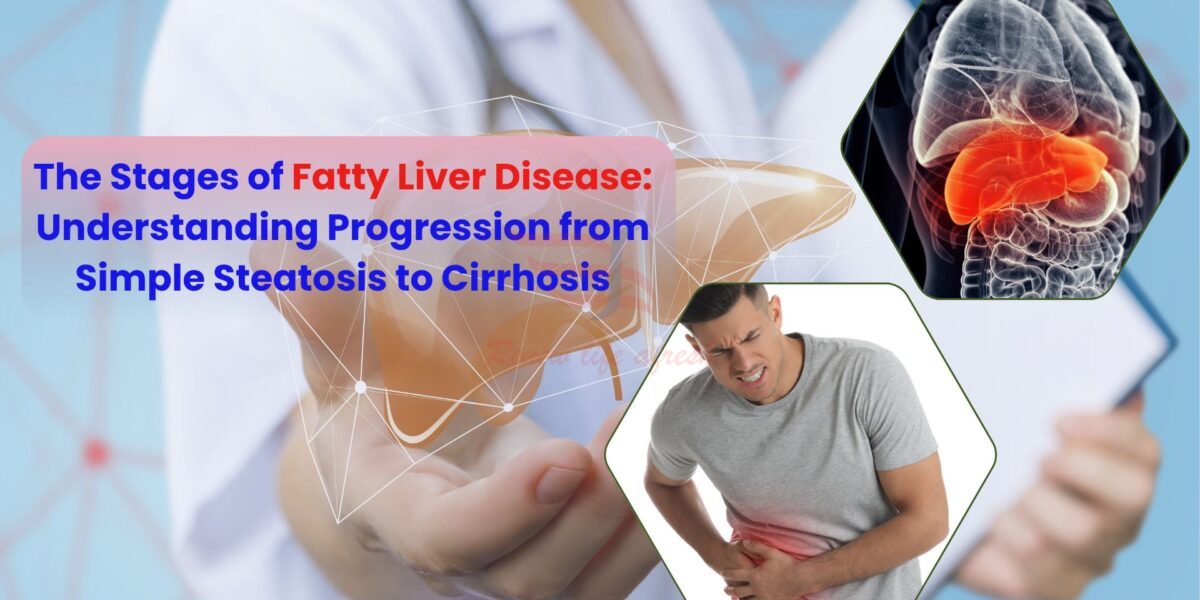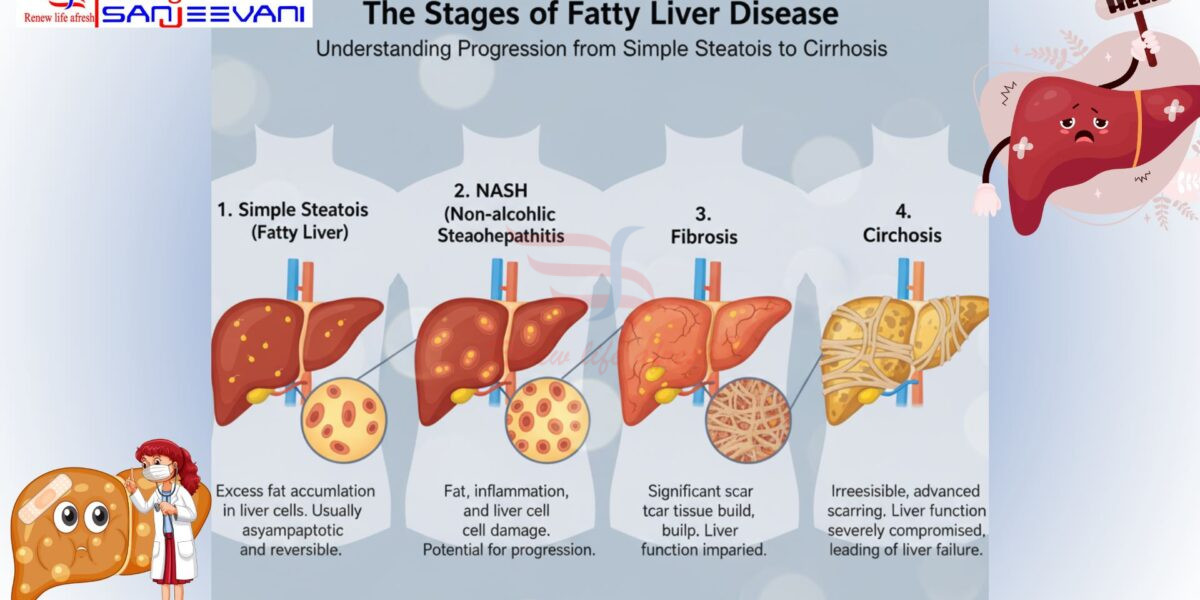The Stages of Fatty Liver Disease: Understanding Progression from Simple Steatosis to Cirrhosis
Fatty liver disease ranks as one of the most widespread liver conditions impacting millions across all age brackets. At Eskag Sanjeevani Hospitals, we think that grasping the progression of this condition is key to early intervention and effective management. This in-depth guide will take you through the stages of fatty liver disease and help you identify when you need to see a doctor.
What is Fatty Liver?
Fatty liver also called hepatic steatosis in medical terms, happens when too much fat builds up in the cells of the liver. While the liver has some fat, it becomes a health issue when fat makes up over 5-10% of the liver’s weight. This problem can show up in two main ways: alcoholic fatty liver disease (which heavy drinking causes) and nonalcoholic fatty liver disease (NAFLD), which affects people who drink very little or no alcohol.

Understanding Nonalcoholic Fatty Liver Disease (NAFLD)
Nonalcoholic fatty liver disease has an increasing prevalence in Western nations affecting about 25-30% of people worldwide. NAFLD has a strong link to metabolic syndrome obesity, type 2 diabetes, and high cholesterol. Unlike its alcoholic counterpart, NAFLD develops without heavy alcohol use making it a condition that can impact anyone regardless of their drinking habits.
The Four Stages of Fatty Liver Disease
Stage 1: Simple Fatty Liver (Simple Steatosis)
The first stage involves fat buildup in liver cells without major inflammation or damage. This represents the mildest form of fatty liver disease.
Key Characteristics:
- Fat builds up in liver cells
- No swelling or scarring
- no signs
- Can be reversed by changing lifestyle
At this point most people don’t notice any fatty liver signs. Doctors often find the condition by chance during regular blood tests or scans done for other reasons. The upside is that simple steatosis can be turned around with the right steps.
Stage 2: Non-Alcoholic Steatohepatitis (NASH)
When fat buildup causes swelling in the liver, the condition moves to NASH. This stage marks a key shift where the liver starts to get damaged.
Key Features:
- Fat builds up and inflammation occurs
- Liver cells start to get damaged
- scarring might start
- Some people may have mild symptoms
Common Fatty Liver Symptoms at This Stage:
- Feeling tired and weak overall
- Pain or discomfort in the upper right belly
- Losing weight without trying
- Not feeling hungry
Fatty liver symptoms in women might include extra signs, though the condition affects both sexes in similar ways. Women may notice small changes in their energy and belly discomfort more .
Stage 3: Liver Fibrosis
Ongoing inflammation causes fibrosis where scar tissue starts to replace healthy liver tissue. The liver can still work at this stage, but it’s losing its ability to function .
Key Characteristics:
- Extensive scar tissue develops
The liver’s ability to function starts to decrease
People notice more symptoms
Chances of turning things around become fewer
Symptoms Can Include:
- Ongoing tiredness
- Swollen belly
- Clear pain in the upper right stomach area
- Bruising or bleeding
- Feeling confused or having trouble focusing
Stage 4: Cirrhosis
Cirrhosis marks the most advanced phase where widespread scarring has affected how the liver works. At this point, the harm is mostly permanent.
Main Features:
- Scarring all over the liver
- The liver struggles to do its job
- Higher chance of liver failure
- Greater risk of liver cancer
Serious Fatty Liver Problems at This Stage:
- Jaundice (yellowing of skin and eyes)
- Severe abdominal swelling (ascites)
- Spider-like blood vessels on the skin
- Confusion or personality changes (hepatic encephalopathy)
- Internal bleeding
- Kidney problems
Is Fatty Liver Dangerous?
The answer hinges on the stage and progression of the disease. Simple fatty liver poses no danger and can be reversed. However, if people ignore it, the condition can advance through the stages causing life-threatening complications.
The real danger exists in:
The disease progresses quietly: Many people don’t know they have fatty liver until later stages
- It raises the chance of heart disease
- It makes type 2 diabetes more likely
- It might lead to liver cancer
- It can cause liver failure needing a transplant
What Causes Fatty Liver: Know Your Risk Factors
To prevent and manage fatty liver, you need to understand what causes it:
Main Causes Include:
- Being overweight or obese
- Having insulin resistance and type 2 diabetes
- High levels of triglycerides and cholesterol
- Metabolic syndrome
- Losing weight too fast
- Taking certain medicines (steroids, some cancer drugs)
- Getting hepatitis from a virus
- Drinking too much alcohol (for alcoholic fatty liver disease)
- Your genes

Fatty Liver Treatment: A Complete Approach
At Eskag Sanjeevani Hospitals, we stress that gastro doctors must customize treatment to each patient’s specific stage and overall health profile.
Lifestyle Changes (Essential for All Stages)
Diet Adjustments:
- Cut down on calories
- Restrict saturated fats and refined carbs
- Eat more fiber
- Skip sugary drinks and processed foods
- Stick to a Mediterranean-style diet full of fruits, veggies, and healthy fats
Weight Control:
- Lose 7-10% of body weight
- Don’t try crash diets or quick weight loss
- Use long-lasting doable weight control methods
Physical Activity:
- Do moderate aerobic activity for at least 150 minutes each week
- Add resistance training to your routine
- Exercise helps your liver even if you don’t lose weight
Managing Fatty Liver with Drugs and Medical Care
Right now, doctors haven’t approved any specific medicine just for treating NAFLD. But they might use different drugs to tackle related issues and problems:
Doctors Often Prescribe:
- Medicines to lower cholesterol (statins)
- Pills to manage high blood pressure
- Vitamin E and other antioxidants (in some cases)
Emerging Therapies: Scientists continue to study specific medications to treat liver inflammation and fibrosis in fatty liver disease. Some drugs show promise in clinical trials, including FGF21 analogues and thyroid hormone receptor-beta agonists.
Important Note: Don’t try to treat yourself. A doctor should prescribe and keep an eye on all fatty liver medications.
How to Reduce Fatty Liver: Practical Steps
1. Get Regular Check-ups: Blood tests help you keep an eye on your liver enzymes and function
2. Control Underlying Conditions: Take care of your diabetes, cholesterol, and blood pressure
3. Limit Alcohol: Alcohol can make nonalcoholic fatty liver disease worse so cut back
4. Avoid Unnecessary Medications: Some medicines can put extra strain on your liver
5. Stay Hydrated: Drinking enough water helps your liver do its job
6. Consider Coffee: Research hints that drinking coffee in moderation might protect your liver
7. Manage Stress: Long-term stress can worsen conditions related to metabolism
Special Considerations: Fatty Liver Symptoms in Females
Fatty liver affects both men and women, but certain things make women more likely to get it:
- Hormone shifts during menopause
- Polycystic ovary syndrome (PCOS)
- Conditions linked to pregnancy
- Unique fat storage patterns
Indian girls and women specially who are obese should keep a close eye on their metabolic health as they go through and finish menopause, since hormone changes can boost the chance of fatty liver.
When to Consult gastroenterologist?
Firstly consult with the best gastroenterologist ifyou notice:
Ongoing tiredness or lack of energy
Stomach pain or swelling with no clear cause
Skin or eyes turning yellow
Pee looking dark or poop looking pale
Bruising or bleeding
Feeling confused or having trouble remembering things
At Eskag Sanjeevani Hospitals, our gastroenterologist doctors are experienced and highly qualified. We use top-notch tools to diagnose:
- Full blood work
- Ultrasound and elastography
- CT and MRI scans
- Liver biopsy if needed
- Fibro scanning
Why Early Detection Matters?
To avoid serious fatty liver issues, doctors need to find and treat the problem . Most people who have simple fatty liver can reverse it by changing their lifestyle. Even those with NASH or early fibrosis can stop it from getting worse with the right treatment.
Prevention Beats Cure
It’s much easier to prevent fatty liver disease than to treat its advanced stages:
- Keep a healthy weight
- Work out often
- Eat well-balanced healthy meals
- Cut down on alcohol
- Control ongoing health issues well
- Skip unnecessary drugs
See your gastroenterologists for check-ups
Consult with the best gastroenterologists docotors at Eskag sanjeevani hospitals (Bagbazar, Baranagar and Khardah).To consult with the best gastroenterologists at Eskag Sanjeevani Hospitals in Kolkata, you can find a team of experienced gastroenterologists across Kolkata. Here is a summary of some of the gastroenterologists and where they practice:
Bagbazar Hospital:
Dr. Sujay Ray: A highly experienced gastroenterologist with over 25 years of experience. He is known for patient-focused care and clinical precision.
Dr. Kingshuk Kumar Dhar: With over 27 years of experience, he is a well-regarded gastroenterologist at the Bagbazar location.
Dr. Agnibha Dutta: He has over 13 years of experience in gastroenterology and also practices at the Bagbazar hospital.
Baranagar Hospital:
Dr. Arghya Chatterjee: With over 17 years of experience, Dr. Chatterjee is a skilled gastroenterologist at the Baranagar branch. He also serves as an Assistant Professor at R.G. Kar Medical College & Hospital.

